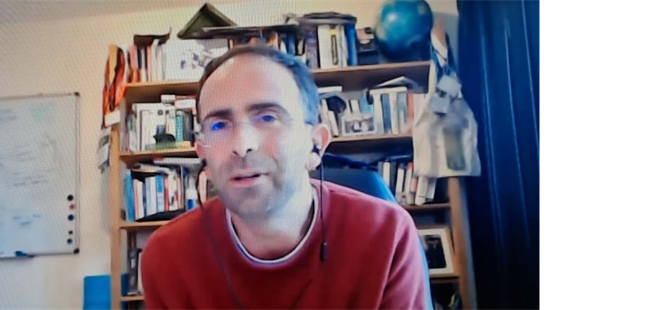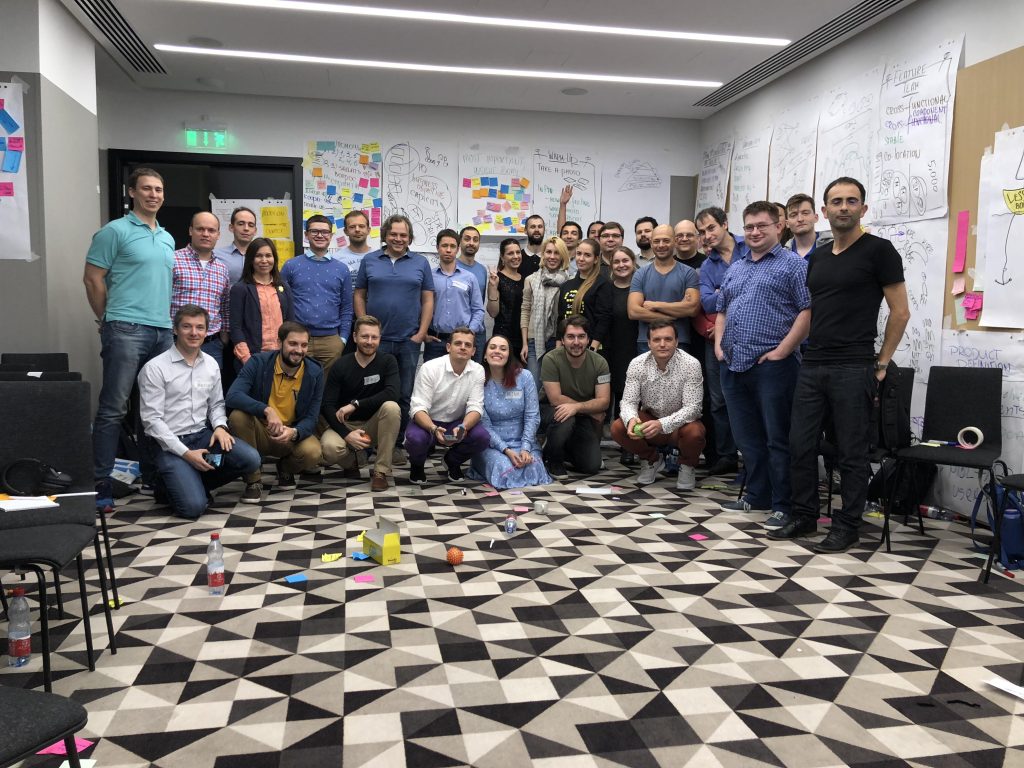Donderdag 25 November een AHN online event met schrijver, coach en drummer CESARIO RAMOS!
>> De inschrijving is al gesloten (21-11) <<
“Was getekend” is een serie gespreksverslagen van kennismakingsgesprekken met professionals die zich in Noord-Nederland bezighouden met werkvormen en activiteiten die te maken hebben met agile werken en wendbaar denken. Elk gesprek is individueel opgezet, soms via digitale bijeenkomsten, tijdens een bijeenkomst of op locatie.
De tekst wordt altijd ter correctie of aanvulling bij de gast neergelegd.
—- The interview is in English! —
Don’t ask me why but I guess it had to do with the rest of the day, which had some English/American classes and deiscussions. 🙂
In mijn scherm verschijnt een veertiger, relaxed gekleed én precies op tijd: Best wel bijzonder voor iemand die aan zijn derde boek werkt, elke dag op de drums slaat terwijl ook nog twee kinderen van 12 en 14 aandacht nodig hebben. Afgestudeerd aan de TU/e in Mathematics and Computer Science. Daarbij is hij ook Certified LeSS trainer in Nederland.

Zijn naam is Cesario Ramos, schrijver van Emergent (*2013), co-auteur van A Scrum Book (2019) en auteur van “Coaching Agile Organizations” dat in maart de boekhandel gaat bereiken. Dat schrijft hij samen met Ilia Pavlichenko.
De hoofdstukken vormen de basis van dit interview als opmaat naar zijn workshop bij AgileHubNoord op.

Het eerste boek is nog met enige moeite te bestellen!
Via zoom heb ik geprobeerd wat meer duidelijkheid te krijgen over het boek en zijn visies, maar als je echt wilt weten hoe het zit dan raad ik je met klem aan om de meetup niet te missen!
Cesario, thank your for joining me here and later this month at an AgileHubNoord meetup. I have received the index of your next book and I’ll try to get some more information on the book and what we can expect at the 25th.
JP: The first chapter is about agility at scale. What do you mean by that?
CR: In the early 2000’s agile was used in small teams, mostly in ICT. Some 6,7 years later the concept found it’s way to other teams and departments, but most were rather small and isolated within the organisation. The results were noticed which lead to senior management looking into expanding the agile methods to more departments and, basically, the complete organisation where complex or innovative services or products are at hand. Multi-disciplinary, multi levels of staff and management. That was the basis, this book is to guide many other companies and organisations.
In order to get change you need a Systems Design
JP: The second and third chapter cover Systems Thinking and Organization Design. What do you mean with these two terms?
Systems Thinking and Systems Design
CR: We use Systems Thinking for looking at the entire organisation, not just an organogram but the interaction between all departments, divisions and teams. That gives a coach or consultant an insight in what happens to the organisation as a whole if you change one or a few elements. A global perspective to changes, which also will show you were your efforts will have the best results.
Design Principles basically meaning the creation of a new system (organization design) for that organisation. Will it be driven by senior management and C-level or will you enable the organisation as a whole? Who has the right and the responsibility to make decisions? It will make help management to guide the lower echelons, to enable the staff on any level of the work floors by giving them resources and asking them to take responsibilities. To obtain change to Agility you need a supporting organization design which will often lead to a smaller, more effective organisation.
JP: Next chapters of your book are on preparing the organization from a coaches’ (or consulting manager) point of view but also preparing the organization. How to make the employees want or need change and are willing to participate. That sounds quite straight forward to most agile users, coaches, or managers?

CR: Basically you have to re-align strategy with people and changes. Formulate and communicate why the change is needed, the plans and the expected results. What (agile) tools will be used to create the desired change and who has to wield these tools.
JP: Launching the product group?
CR: Based on the Scrum framework: The group of products or services that you have identified now has to be embedded in the changed organization. Most organisations consist of silo’s, that have to work together. By redesigning the system you have found the ways for those silo’s to interact in a different way, centred around the product or services.
JP: Does that mean silo’s have to be interconnected or do they have to be torn down?
CR: Part of these silos are (partly )eliminated by the new organization design, that should be part of your approach.
Chapter 7 is about coaching teams toward other kinds of interaction, services to the teams, facilitation and more. I will skip this chapter as the interview should not be way too long. And of course, people have to get the book!
The value is in the unlearning first and than the learning.
JP: Chapter 8 is about service to the product ownership. It deals with complex issues like people learning new roles and responsibilities, moving from output to outcome based but also things like planning and budgetting.
CR: In the book we cover the ways on how to make people take ownership, of changing their ways and adapt to the changes that have to be made. A new senior management role in the form of Product Ownership is a key part of this. It is a person with a deep understanding of the product and process and is responsible for creating value to customers.
The changes we are promoting are based on the plans that the company has made with its stakeholders. To realize these plans and achieve the desired results changes are necessary. When an organization does not have the right tools or capabilities, they need to change. Our markets, our customers are changing fast which means we must be able to change fast as well. The need for changes are known, but how to get those desired changes? Adapting fast to reach strategic goals means urgency.
Changing an entire organisation will seldom succeed so you have to focus on the changes that will bring the most value in a short timeframe. It works best with innovative or complex products and services. There is no solution that will always work out of the box. The value is in the unlearning first and than the learning new ways of working. These are crucial for success. Big frameworks that provide all the answers don’t exist.
Today I won’t talk about chapter 9, we will leave that to the AgileHubNoord meetup. It’s about case studies. The AHN organisers each had different views on which chapter has to be discussed, but every single one named chapter nine.
JP: Thank you for this interview and we are looking forward to hear and see you at the November 25 meetup!
—- Finding or buying the books—
Just click on this line! Brengt je meteen naar Amazon page van Cesario. En nee, geen affiliate voor AHN 🙂
—- the index —
Chapter 1 – Organizing for adaptability is about the problems that organizations face when adopting agility at scale. What are typical problems, organizational de-sign flaws and what would need to change in order to be successful.
Chapter 2 – Systems Thinking describes the overarching approach to improve on organization—Systems Thinking. We introduce the basic concepts and techniques and lay the foundation for the rest of the book.
Chapter 3 – Organization Design describes organization design principles for use when working in the leadership level of an organization.
Chapter 4 — Coaching for Change provides guiding principles on how to make the change successful in your organization.
Chapter 5 – Preparing the Organization focuses on how the coach and organiza-tion work together. How to formulate objectives? measures? and plan the adop-tion? We will describe how to organize for agility and discuss various techniques and tools including the fundamental initial steps of an adoption.
Chapter 6 – Launching the Product Group shows how to successfully launch the product group and prepare to work in the new organization design. We give a sequence of activities and techniques you can consider in your launch.
Chapter 7 – Coaching Teams is about the service to the teams in a large group, including lift-off of teams, assessments, large scale facilitation of events, team relationships and coaching techniques.
Chapter 8 – Guiding the Product Ownership is about service to product ownership of a large product group. Who is the right person to become the Product Owner? How to move away from output to outcome-based delivery, how to work with mul-tiple teams and techniques for planning and budgeting.
Chapter 9 – Case Studies presents various adoption examples.



